Biteye: In-depth Analysis of Account Abstraction AA User Growth Data
Author: Biteye Core Contributor Louis Wang
Editor: Biteye Core Contributor Crush
In September 2021, ERC4337 was officially proposed as a standard for account abstraction, aiming to improve the account experience in the Ethereum ecosystem through smart contracts.
This approach does not require modifications to the Ethereum consensus layer, making it easier to implement, and the potential for higher gas consumption will be significantly mitigated with the development of Layer 2 and the subsequent launch of the Cancun upgrade.
February 28 of this year marked an important milestone for ERC4337, with the EntryPoint contract deployed on the Ethereum mainnet, and it has since expanded to over 20 EVM-compatible blockchains.
Since its launch six months ago, an increasing number of users, infrastructure, and dApps have begun to build their on-chain applications based on this EntryPoint contract. So, what are the user metrics for participants? How are infrastructure builders and dApps performing?
We will explore the performance of ERC4337 over the past six months through data analysis of the EntryPoint contract.
01 Introduction to ERC4337
The Ethereum account system can be simply divided into EOA (Externally Owned Account) and CA (Contract Account). EOA is the native account of Ethereum, used to trigger Ethereum transactions;
CA is essentially a smart contract, providing great flexibility and programmability, which can lead to a better user experience. However, it cannot directly initiate Ethereum transactions, and using CA still cannot escape the issues brought by EOA, such as private key risks.
In the ERC4337 account abstraction standard, users can fully control their CA and verify using any method they prefer, while the task of initiating Ethereum transactions will be executed by Bundler.
The simple process is as follows:
Users initiate a UserOperation (UserOp) using CA, a new type of transaction proposed by ERC4337, sending it to a separate UserOp mempool.
Bundler will package the UserOp into a transaction from this mempool and initiate a transaction to the EntryPoint contract using their EOA account. Since the transaction is initiated by the Bundler, they will also pay the gas fees.
The EntryPoint contract is used to standardize transaction execution and prevent bundlers from being subjected to malicious transaction DoS attacks. All Bundlers need to call it to execute UserOp.
Users must pre-deposit gas in the EntryPoint contract to pay the Bundler, or it can be paid on their behalf by a Paymaster, which can be any third party willing to cover the gas fees.
If a user has not created a contract wallet, the wallet factory contract will automatically create a smart contract wallet for the user.
02 User Analysis
User Growth
Currently, over 680,000 account abstraction wallets based on the ERC4337 standard have been created, initiating over 2 million UserOps.
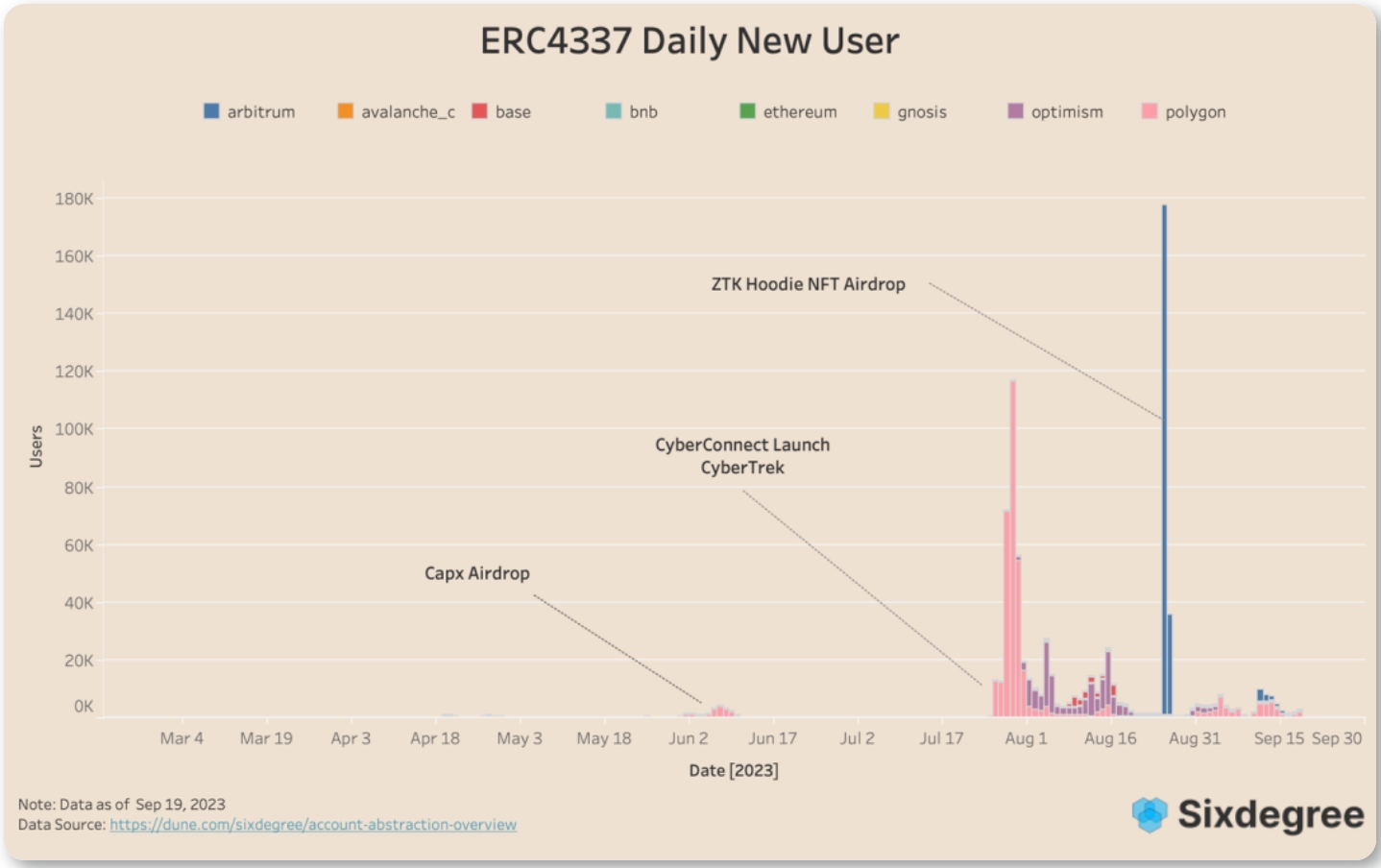
From the above chart, we can see that the number of AA users has experienced three major growth spurts:
The first was brought by the project The Capx App, a learn-to-earn app that utilizes the advantages of AA's bundling operations for token transfers. This platform has developed rapidly and has built an app chain based on zk-rollup technology using Polygon's SDK.
The second growth came from CyberConnect's Cyber Trek event, which incentivized users to create Cyber Accounts based on AA.
The third growth was from the metaverse project ZepetoX (ZTX) on Arbitrum. Zepeto is a virtual fashion social platform launched in August 2018 by South Korean internet giant Naver (the parent company of the social app LINE), allowing users to create their personal digital avatars, while ZTX is their new project extending into Web3.
User Activity
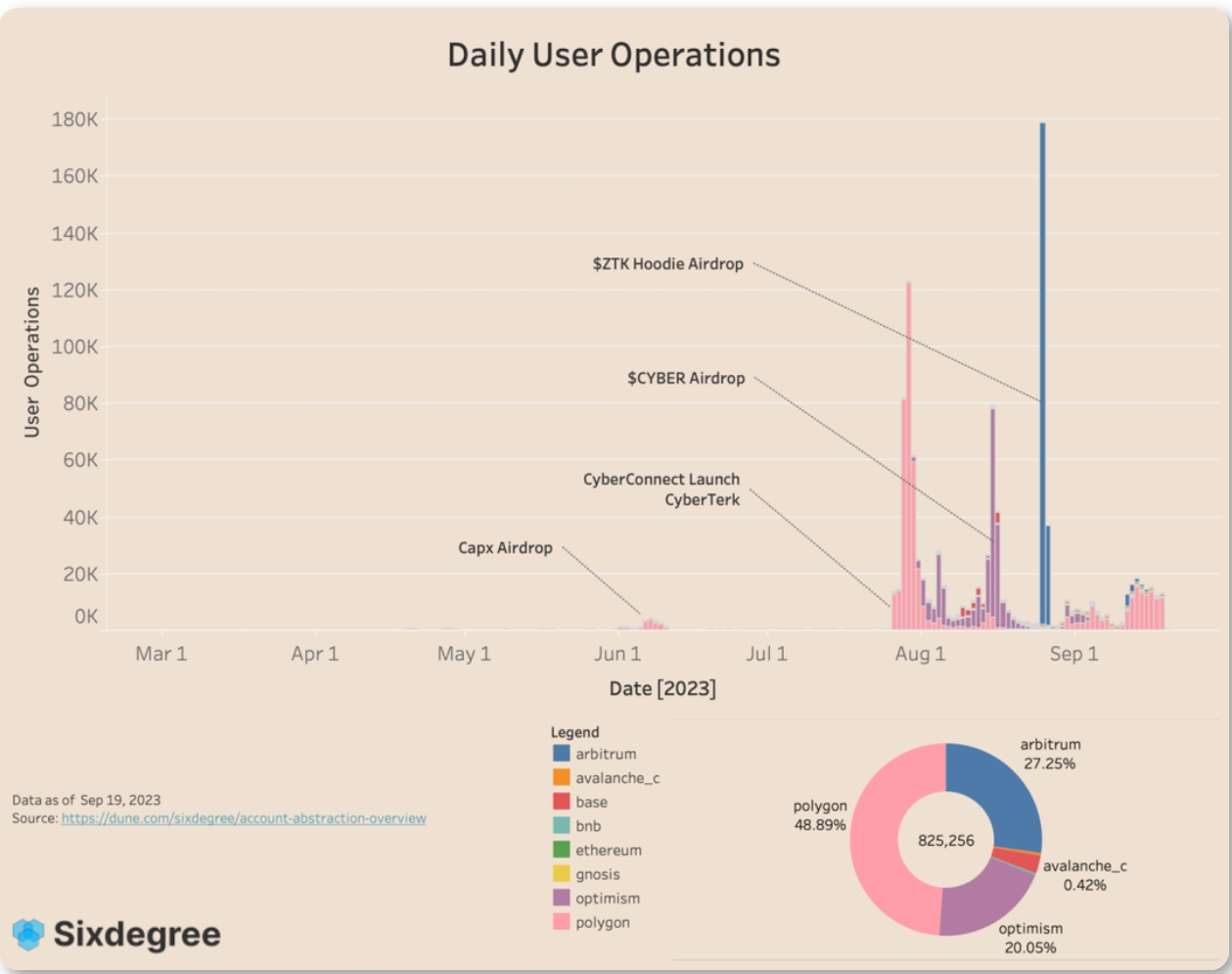
The growth of UserOps generally follows the user growth curve, with the only difference being that UserOps experienced four growth spurts due to CyberConnect's airdrop on the Optimism mainnet, requiring users to claim it using AA wallets.
Since account abstraction based on ERC4337 calls more contracts, it incurs additional gas burdens, so most UserOps occur on Layer 2, where gas costs are lower.
Among them, Polygon, Arbitrum, and Optimism account for the majority, with shares of 48.89%, 27.25%, and 20.05%, respectively.
The art creation trading platform Zeroone on Avalanche launched on August 18, bringing over 40,000 UserOps, while the Base chain saw a slight increase due to the recent Onchain Summer.
Overall, user activity shows a gradually increasing trend.
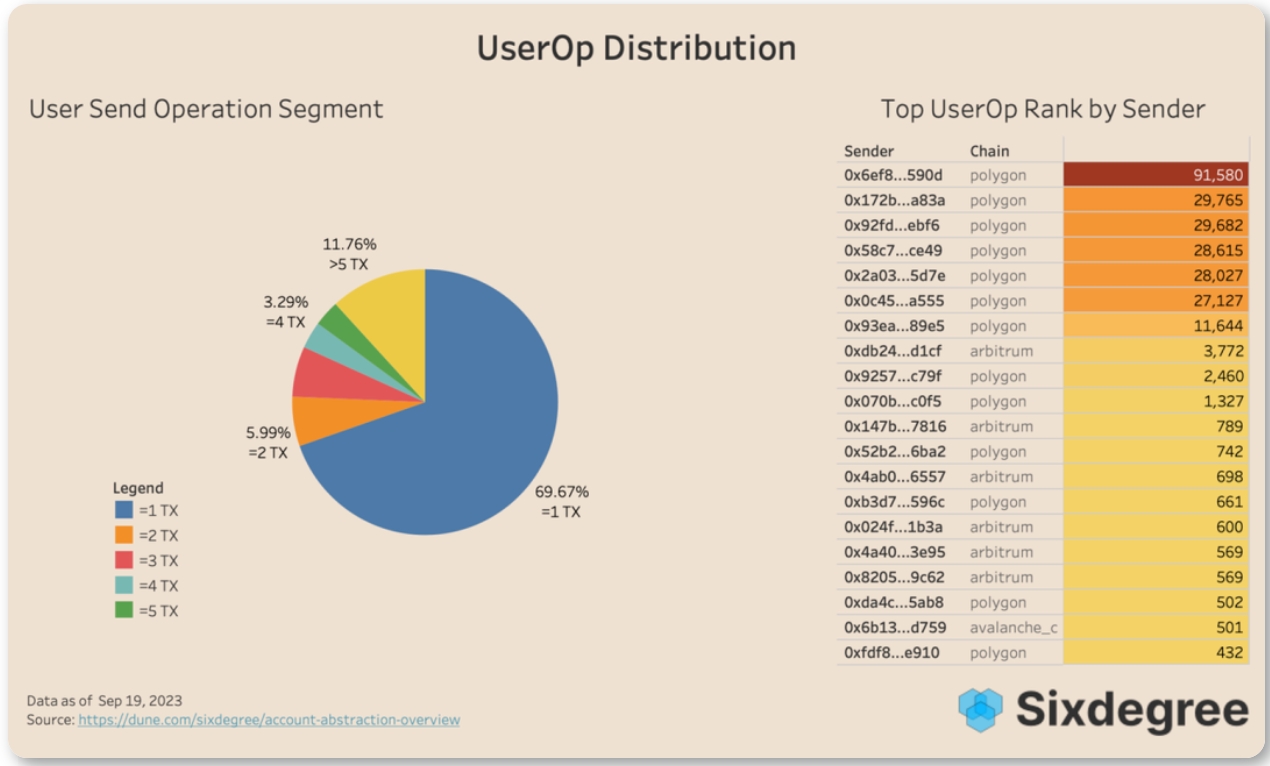
Looking specifically at the activity of each AA wallet, 88.24% of wallets have used the service five times or fewer. Combining this with the user growth and UserOp growth charts, it indicates that most AA wallet users are one-time users brought in by projects, meaning there are not many additional applications beyond the specified operations of the projects.
There are two main reasons for this:
First, most of the 4337AA wallets are in-app AA wallets built by the project teams themselves;
Second, most mainstream projects have not yet integrated AA compatibility. Therefore, there is no situation where users use CyberWallet to claim ZTX commemorative NFTs, which means user behavior is confined to these apps.
There are also a small number of AA wallets with particularly high usage, even thousands or tens of thousands of times. For example, the wallet 0x93 initiated over 11,000 UserOps, which is used by Capx to distribute tokens, so only a few project teams have actual usage scenarios that truly leverage the advantages of AA wallets.
User Behavior
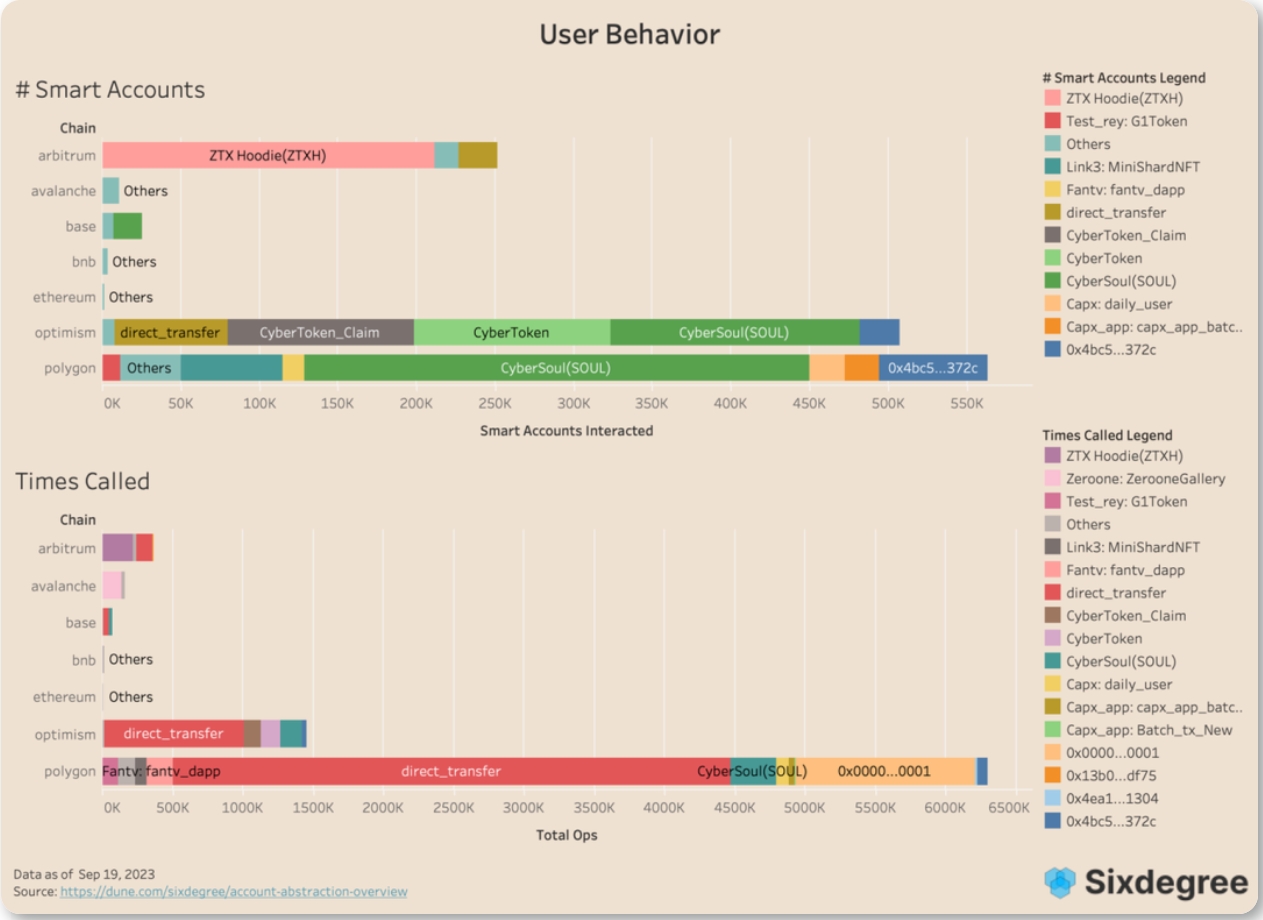
Focusing on the scenarios where users utilize AA wallets on-chain, Polygon has the most interaction scenarios in terms of the richness of interactive contracts.
Among them, CyberConnect and ZTX are the main contracts interacted with by AA wallets. Based on the number of contract calls, most actions are primarily direct transfers and NFT minting, accounting for 90% of all user operations.
Taking Polygon as an example, direct transfers are just a small portion of user interactions, but the number of uses is the highest, which also confirms that only a small number of people have truly found suitable AA usage scenarios.
03 AA Infrastructure
Currently, most AA wallets using ERC4337 are built in a Lego-like manner, using different third-party modules to assemble their in-app AA wallets. The advantage is convenience and ease of implementation, while the downside is a lack of universality. The following will analyze the market situation of each module and the main participants.
Bundler
Bundlers use EOA to trigger transactions, freeing users from the troubles of EOA, and they possess strong public good attributes, as well as expected wealth effects.
Bundler's revenue comes from two parts: one is the gas difference, which is the difference between the maximum priority gas fee and the actual gas expenditure, while spreading the fixed gas costs across multiple users to profit from these frictions;
The second is potential MEV profits. The role of the bundler is very similar to that of block builders; when a user's UserOp contains MEV profits, the bundler can also include their transactions to capture this profit.
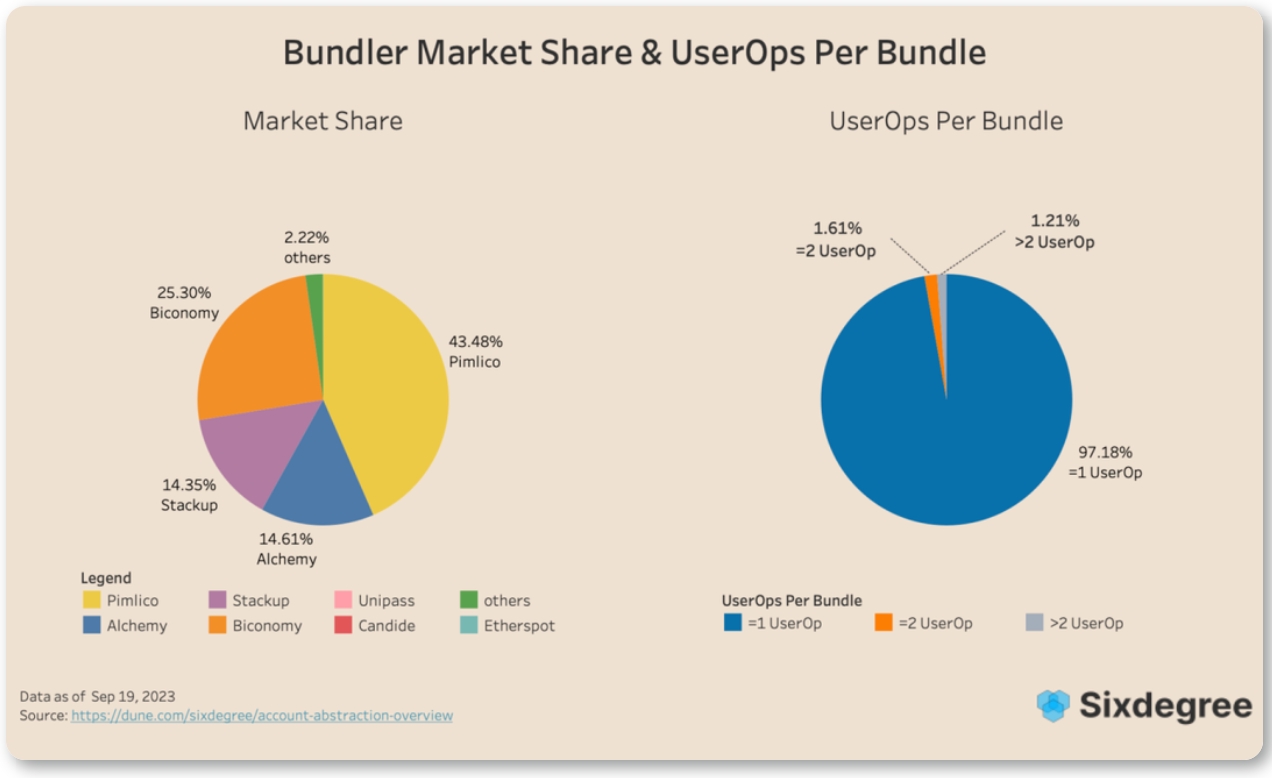
Currently, there are about 1,500 bundlers, with Pimlico, Alchemy, Biconomy, and Stackup being the most prominent players, collectively accounting for over 97% of the bundler market.
Among them, Pimlico has secured 43.48% of the market share by extensively collaborating with various dApps, packaging the most UserOps.
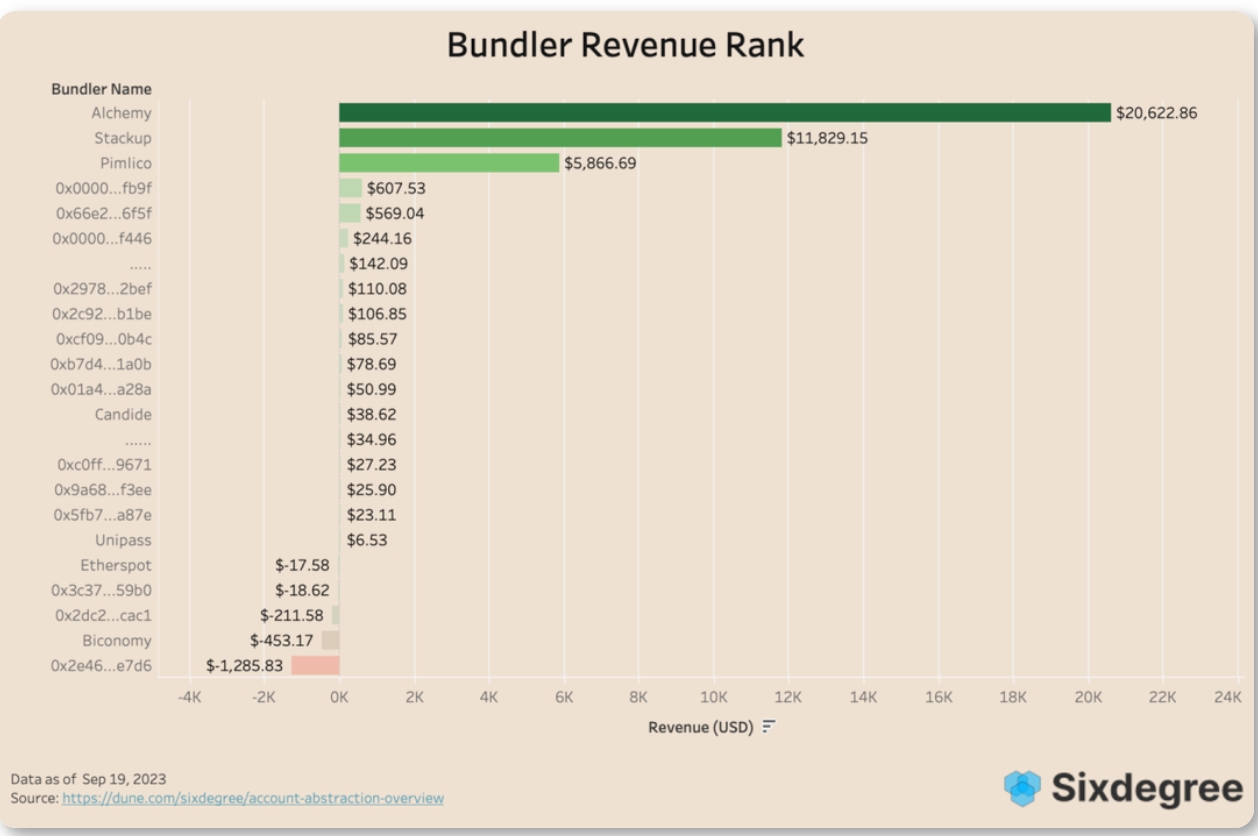
Bundlers can package multiple UserOps into one transaction, but in reality, 97.18% of transactions only contain one UserOp.
This indicates that there are currently not enough UserOps, leading to Bundlers' workloads being completely underutilized, further resulting in almost no profit margins for bundlers.
Currently, all bundlers have generated about $38k in profits, with 88.38% operating at break-even, among which Alchemy leads with $20k in profits, followed by Stackup and Pimlico with $11k and $5.8k, respectively.
Paymaster
As an optional component of the ERC4337 standard, in fact, 96% of UserOps have their gas fees paid by Paymaster, indicating that the vast majority of users are using dApps that have enabled this feature, creating a gasless experience for users.
Currently, there are 117 Paymasters that have collectively covered $465k in gas fees, with Stackup, Pimlico, Alchemy, and Biconomy accounting for the vast majority.
Among them, Pimlico has covered the most UserOps, accounting for 43.45% of the total, covering $144,000.
Next, Stackup accounts for 14.5%, while Alchemy and Biconomy account for approximately 16.43% and 23.29%, respectively.
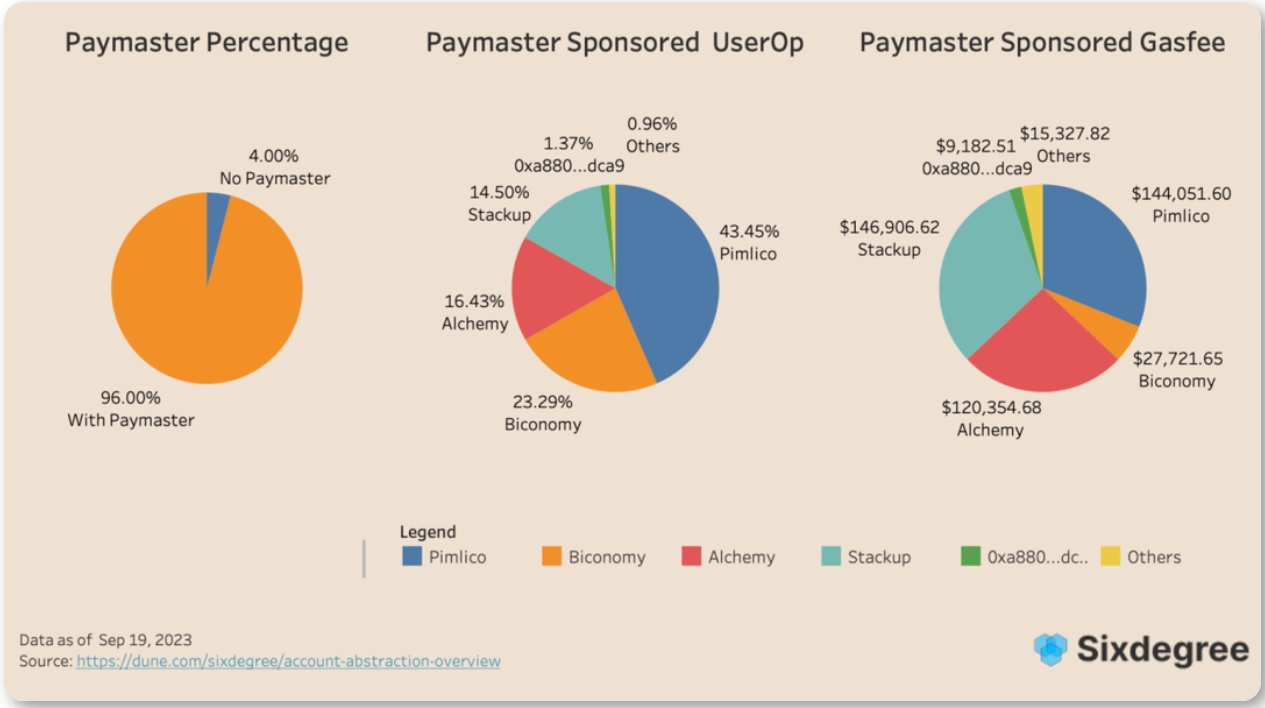
A notable point is that Pimlico's Paymaster pays significantly lower gas fees per UserOp compared to Stackup and Alchemy, which leads to the number of UserOps it covers being twice that of the other two, while the total gas fees paid are quite similar.
The differences may arise from the different contracts called by different UserOps; Pimlico has covered a significant number of dApp applications and direct transfers, many of which involve low gas-consuming operations, thus leading to the aforementioned gas fee differences.
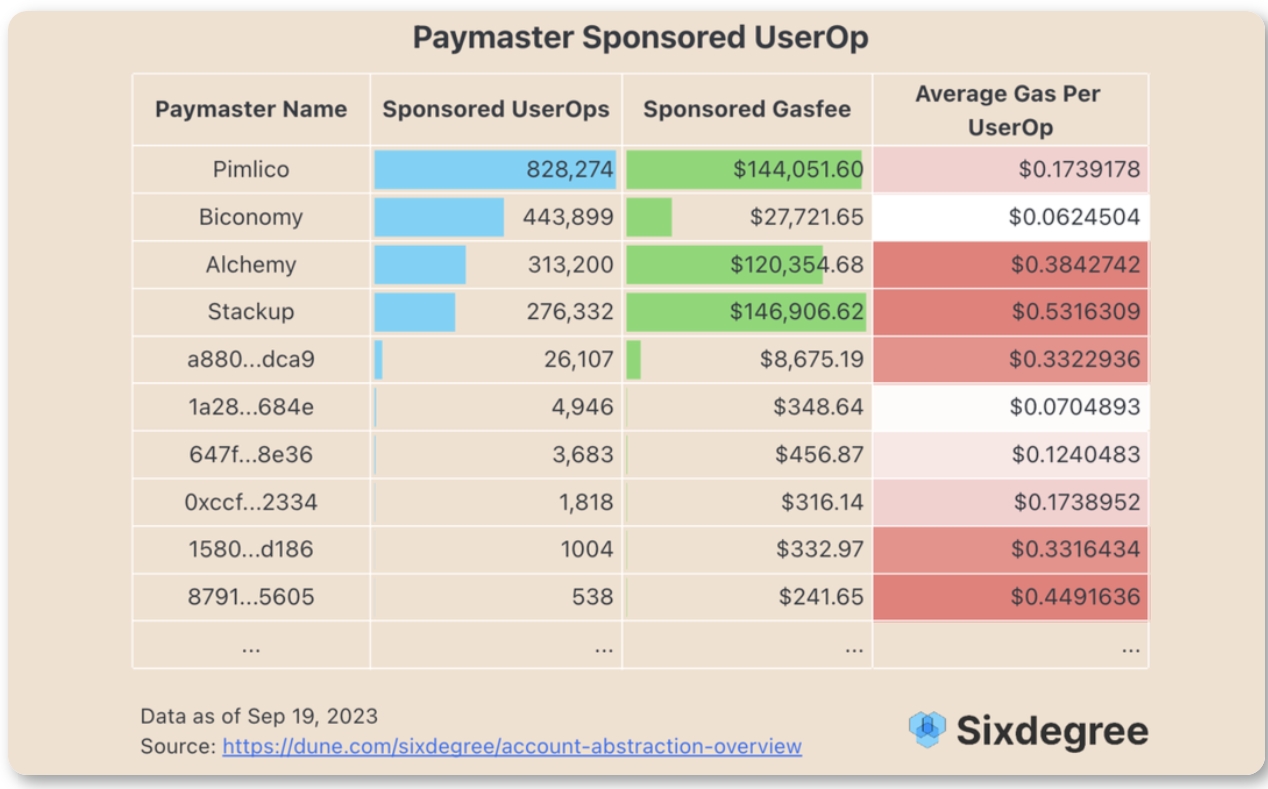
Wallet Factory
In terms of market share, currently, only ZeroDev dominates with 62.86% of the market, benefiting from its collaboration with CyberConnect. The second place is held by ZTX, which uses the official ERC4337 contract repository from the Ethereum Foundation's SimpleAccountFactory. There have not yet been large-scale wallet applications, and projects like Soulwallet have not yet shown any on-chain cases.
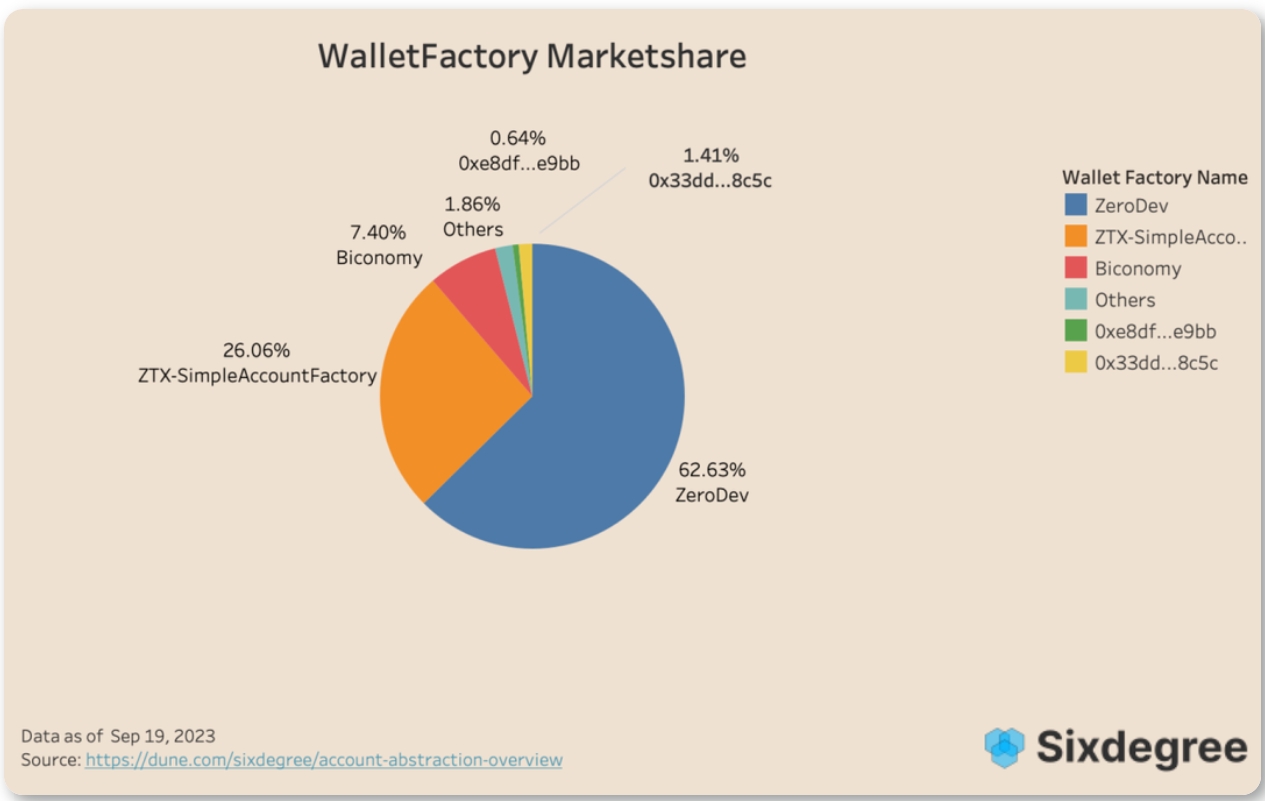
04 Conclusion
Since the launch of ERC4337 six months ago, we can see that AA based on ERC4337 has shown a significant growth trend in both user numbers and transaction counts. Each time an application adopts ERC4337, it brings a wave of growth.
However, currently, users and transactions are concentrated on a few applications across several chains, and the types of UserOps are quite limited. On one hand, most AA wallets are in-app forms with no universality; on the other hand, 4337 is still in its early stages, with mainstream applications not providing login interfaces.
Finding suitable application scenarios for AA is a prerequisite for broader adoption of 4337. With the maturation of blockchain infrastructure, we look forward to seeing more application products and full-chain games emerge in the next 12-24 months. As the business logic of Web3 projects becomes more complex, and with the inherent complexity of full-chain games, AA wallets will become key to lowering user thresholds and enhancing user experiences.
As one of the three major lines of Ethereum pointed out by Vitalik, the significance of account abstraction is immense and is an important prerequisite for achieving mass adoption in the future. We are very much looking forward to and firmly believe that account abstraction will be an important part of the future of blockchain.
References
[1] https://sixdegree.xyz/research/Half-Year-Data-Report-of-ERC4337-by-Sixdegree.pdf









